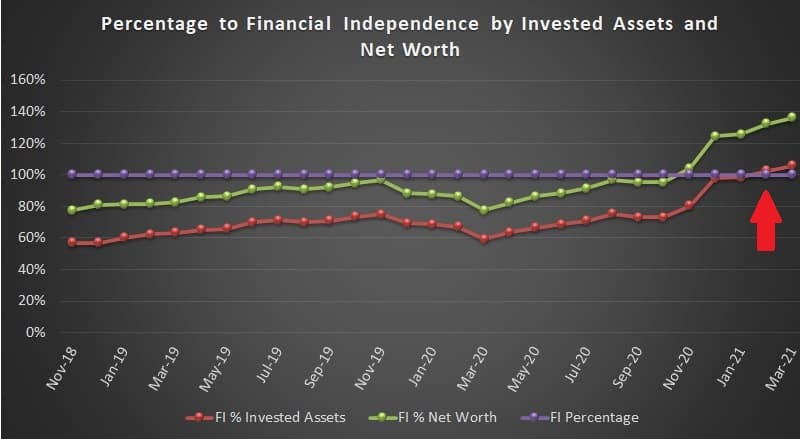 The monetary independence quantity is a benchmark to find out retirement preparedness. It’s often known as the FI quantity.
The monetary independence quantity is a benchmark to find out retirement preparedness. It’s often known as the FI quantity.
Monetary independence is achieved by:
- constructing sufficient passive earnings to cowl annual bills, or
- amassing a lump sum of sufficient financial savings and investments to cowl residing bills by withdrawals, or
- a mixture of #1 and #2.
The monetary independence quantity is the goal lump sum. Calculating the quantity solutions the query, how a lot cash do I must cease working full-time?
Although not good or set in stone, there are years of knowledge and analysis behind utilizing this single quantity to assist decide the long-term viability of a retirement nest egg.
The monetary independence quantity works superb as a baseline guidepost, however most individuals ought to tweak it to optimize long-term targets and plan conservatively in preparation for the surprising.
This text explains the origins of the monetary independence quantity, methods to calculate it, and methods to customise it in your planning functions.
Origins of the Monetary Independence Quantity
The origins of the monetary independence quantity return to the Nineties and the work of an advisor named William Bengen. Later, three professors at Trinity College printed a paper about secure retirement withdrawal charges constructing on Bengen’s evaluation.
The three professors checked out inventory and bond information from 1925 to 1975. They concluded {that a} retiree might safely withdraw 4% of their whole belongings per 12 months over any thirty years throughout that interval with out working out of cash.
For instance, if somebody entered retirement with $1.5 million of invested belongings, they might withdraw $60,000 per 12 months for residing bills for the subsequent 30 years. The individual would have a >98% likelihood of a solvent retirement.
The paper turned often called the Trinity Examine, and its conclusion is the premise for the 4% rule of thumb, which we use to calculate the monetary independence quantity.
If historical past is any information for the long run, then withdrawal charges of three% and 4% are extraordinarily unlikely to exhaust any portfolio of shares and bonds throughout any of the payout intervals (from 1925 to 1995).
The 4% rule of thumb has turn into an important retirement planning software for advisors and particular person buyers.
Analysts have replicated the examine many instances since, utilizing up to date information and coming to comparable conclusions. An advisor and influential blogger named Michael Kitces is without doubt one of the extra outstanding fashionable researchers.
His look on the Larger Pockets Cash Podcast is a wonderful overview of the 4% rule of thumb and different planning methods.
Learn how to Calculate Your Monetary Independence Quantity
The monetary independence quantity equals annual family spending divided by 4%.
This components serves because the baseline, however most individuals ought to take into account adjusting the quantity for his or her private state of affairs.
To calculate the quantity, first decide annual spending. Rely whole expenditures for the 12 months or common month-to-month bills. You’ll want to add estimated post-employment healthcare bills since employer advantages will stop in retirement.
I want to make use of checking account information and a spreadsheet to calculate annual bills utilizing Excel pivot tables.
After getting the annual spending quantity, divide it by 4% (0.04). Or a number of your annual spending by 25. Both approach works.
The full is the monetary independence quantity.
We’ll use $75,000 annual spending within the examples all through this publish.
= 75,000 / .04 = $1,875,000 = 75,000 * 25 = $1,875,000
One other approach is to take your common month-to-month spending and a number of it by 300 (12*25)
= 6,250 * 300 = $1,875,000
The purpose is to save lots of this whole lump sum by aggregating all investments, financial savings accounts, and different funding fairness. When you’ve hit the quantity, you’ve reached monetary independence.
Use it as a wealth-building measuring software to trace your invested belongings as a proportion of your monetary independence quantity (see chart on the backside).
However don’t take into account the monetary independence quantity as an absolute finish purpose as a result of there are a lot of different components to contemplate.
What are Invested Property?
Whole invested belongings is completely different than internet price.
Some folks calculate their internet price and use that to measure progress towards monetary independence. That’s simpler however much less correct.
Keep in mind, the purpose is to construct a lump sum of financial savings and investments (or “invested belongings”) equal to the monetary independence quantity.
For a greater image, exclude the fairness worth of your major residence and different non-retirement funds corresponding to faculty financial savings accounts.
Do embody the worth of fairness in funding actual property properties or different belongings you’ll be able to liquidate to purchase different income-producing belongings.
Moreover, suppose you generate after-tax earnings from shares, bonds, or actual property investments. In that case, it’s possible you’ll select to exclude the underlying belongings out of your invested belongings calculation and cut back your monetary independence quantity — extra on that under.
Learn how to Customise Your Monetary Independence Quantity
One of many extra notable takeaways concerning the 4% rule of thumb from the earlier-mentioned podcast with Michael Kitces is:
- there’s a 50% likelihood the retiree will find yourself with nearly 3X the unique financial savings
- there’s a 96% likelihood the retiree will find yourself the place they began 30 years prior
- there’s a couple of 1% likelihood of ending up with zero.
Which means the 4% rule of thumb is a conservative benchmark meant for probably the most risk-averse.
These keen to just accept extra danger can withdraw a bit extra, say 4.5%, and nonetheless have likelihood of sustaining retirement safety for 30 years.
That stated, 4% could also be too dangerous for early retirees.
The 4% rule works over 30 years. For somebody of their 60s, it’s prone to final the remainder of their lives.
However for early retirees of their 30s, 40s, or 50s, 30 years is probably not a adequate planning horizon.
Thus, a extra conservative 3%-3.5% withdrawal charge could also be extra acceptable for these with an extended life expectancy or who wish to depart a monetary legacy.
Decreasing the withdrawal charge is without doubt one of the best methods to cut back danger.
One other approach is to cut back annual spending.
There are different methods to customise your monetary independence quantity by accounting for added earnings or income-producing belongings.
I’ve written particularly about how I measure progress towards monetary independence utilizing the F12MII quantity from my portfolio. Under is a extra basic description of methods to modify the quantity.
Adjustment for Extra Earnings
Folks generally overestimate how a lot they should retire and preserve working a job they don’t love.
In the event you anticipate to obtain earnings after retirement, you’ll be able to cut back your monetary independence quantity and bump up your retirement date.
The obvious further earnings stream within the U.S. is Social Safety. Youthful people wish to plan for retirement with out Social Safety due to doubts it should exist.
That’s an unlikely situation.
Regardless of politics and deficits, all People ought to anticipate to obtain Social Safety after they attain retirement age.
For instance, should you anticipate to obtain $2,000 per 30 days in Social Safety advantages at a sure age, that’s $24,000 per 12 months.
Utilizing the earlier instance of $75,000 in annual bills, now you can calculate your monetary independence quantity utilizing an adjusted spending foundation. The extra earnings covers a portion of the spending.
= (75,000-24,000) = $51,000 * 25 = $1,275,000
On this instance, we’ve decreased the monetary independence quantity by $600,000, down from $1,875,000.
That shaves off a number of years of labor should you comply with the 4% rule of thumb and don’t thoughts counting on the federal government as a part of your plan.
The lesson right here is that slightly little bit of further earnings goes a great distance.
This sort of adjustment works effectively for Social Safety, pensions, and earned earnings (part-time work) as a result of there’s no underlying invested capital producing the earnings.
Invested capital that produces earnings is a bit completely different.
Adjustment for Earnings-Producing Property
Once I write about income-producing belongings and constructing earnings streams, I’m normally referring to investments that create passive earnings. These investments embody dividend shares, bonds, conventional and crowdfunded actual property, sure enterprise earnings, and different financial savings.
In the event you regulate the monetary independence quantity down because of income-producing belongings, you must take into account subtracting the underlying asset quantity from the pool of obtainable secure withdrawal belongings.
For instance, let’s say you’ve gotten a $200,000 taxable dividend development account that yields 3.0% and generates $6,000 in annual earnings earlier than tax. You possibly can cut back the premise of your yearly bills by $6,000, thus decreasing your monetary independence quantity by $150,000 (= 6000 * 25).
The $200,000 shouldn’t be included in your whole invested belongings aggregation should you cut back the monetary independence quantity.
Right here’s a side-by-side comparability constructing on our earlier instance. The primary is calculating the monetary independence quantity with out changes. The second adjusts for the dividend portfolio.
We’ll assume the investor has $1,000,000 of invested belongings.
Annual spending = $75,000 Monetary independence quantity = $1,875,000 Whole invested belongings = $1,000,000 Share to monetary independence = 53.33%
Annual spending = $75,000 Monetary independence quantity foundation = $1,875,000 Whole invested belongings = $1,000,000 Dividend portfolio worth = $200,000 Adjusted invested belongings = $800,000 Dividend earnings (earlier than tax) = $6,000 Adjusted annual spending = $69,000 Adjusted monetary independence quantity = $1,725,000 Share to monetary independence = 46.37%
The second instance reveals slower progress as measured by the proportion of economic independence.
So why cut back the monetary independence quantity by $150,000 when you would be $200,000 nearer to your preliminary goal? What’s the good thing about making this extra sophisticated?
For planning functions, you are able to do it both approach. However most of us are extra involved a couple of safe retirement than a extra imminent one.
Utilizing this technique accounts for belongings we don’t plan to liquidate.
Constructing and sustaining sustainable earnings streams will assist to lengthen retirement safety with out the only real reliance on withdrawals.
Dependable earnings is significant for early retirees to assist maintain prolonged retirement intervals. It could possibly additionally assist fund long-term well being bills, help relations in want, and preserve wealth to go away a monetary legacy to household or charities.
Conclusion
Years in the past, once I set a purpose to retire at age 55, I anticipated that I’d be capable of generate sufficient passive earnings from dividend shares to fund my retirement way of life.
Now that I’m 49 and my retirement account balances have soared, I can retire sooner through the use of a hybrid method to funding my retirement.
I’ll depend on each sustainable earnings from dividends and actual property, and I’ll faucet my tax-advantaged accounts once I attain age 59 1/2.
Since this realization, I’ve custom-made my monetary independence quantity to account for income-producing belongings that I don’t intend to liquidate. The additional calculation complicates the equation a bit as an alternative of simply utilizing 25x annual spending.
But it surely serves me higher, giving me an intensive image of what I want to perform to achieve F.I.B.E.R.
Under is a chart that I’ve been plotting since November 2018. It reveals my internet price (inexperienced) and invested belongings (pink) as a proportion of my monetary independence quantity (purple line).
I calculate my annual bills for the calendar 12 months. In February 2021, I reached monetary independence.
The purpose is to KEEP the pink line above the purple line and develop the unfold between them till I retire.
The broader the unfold between pink and purple, the safer and comfy my retirement might be. It would additionally improve my probabilities of leaving a monetary legacy to my household.
 Featured photograph by way of DepositPhotos used beneath license.
Featured photograph by way of DepositPhotos used beneath license.

Craig Stephens
Craig is a former IT skilled who left his 19-year profession to be a full-time finance author. A DIY investor since 1995, he began Retire Earlier than Dad in 2013 as a artistic outlet to share his funding portfolios. Craig studied Finance at Michigan State College and lives in Northern Virginia together with his spouse and three kids. Learn extra.
Favourite instruments and funding providers proper now:
Positive Dividend — Obtain the free Dividend Kings checklist, 50+ shares with 50+ consecutive years of dividend will increase. (assessment)
Fundrise — Easy actual property and enterprise capital investing for as little as $10. (assessment)
NewRetirement — Spreadsheets are inadequate. Get severe about planning for retirement. (assessment)
M1 Finance — A prime on-line dealer for long-term buyers and dividend reinvestment. (assessment)

